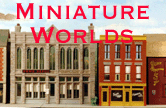
According to the text that accompanied the photograph of my model in the 1980 Walther's HO Railroad Catalogue, "The Union Pacific takes pride in the territory it serves. In an earlier, unhurried age, it had a special car outfitted as a photographer's studio. This car followed the UP tracks to big cities and long-forgotten ghost towns, recording for posterity the dramatic awe-inspiring beauty of the old West." I built this unusual bit of rolling stock from a kit from Wabash/Red Ball. The photographer's studio-car, which is constructed of wood and silk-screened cardboard sides, represents a transitional period in railroad modelling between the very first crude kits and the extraordinarily detailed ones that advances in injection-molding plastic permitted by Gould and others permitted.
Another major improvement modelling involved methods of putting lettering and logos on rolling stock. Champ and various custom decal manufacturers products permitted one to have freight and other railroad cars for otherwise unavailable lines, including fictional ones, such as the Albion, Pawtuxet, & Gallilee. In the decade or so that I was away from model railroading another advance took place: computer-assisted printing methods permitted manufacturers of plastic cars to print exquistely fine text and logos on widely available ready-to-run cars, and the ease of changing the print run permitted manufacturers to offer, apparently for the first time, a numbered series of cars; that is, modellers could now buy a set of box cars each of which had separate numbers, something impossible in the past. One result, of course, has been to put at least some major pioneering decal companies out of business.
A black-and-white photo of this model appeared in "Make Mine an Old Timer" (1979 Railroad Modeler)

